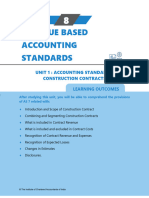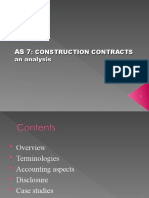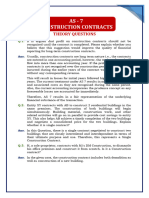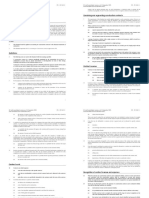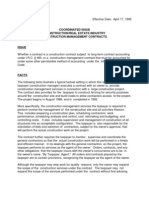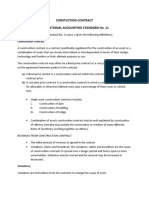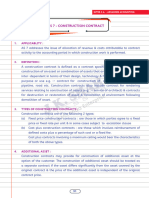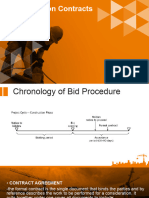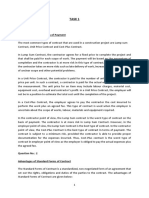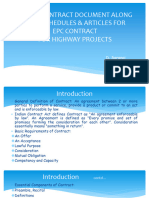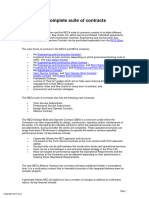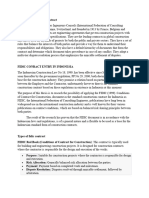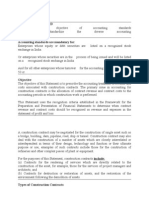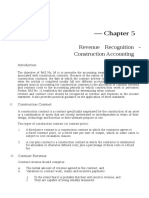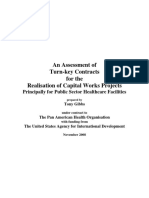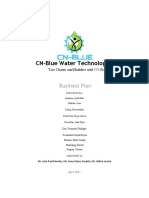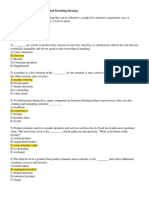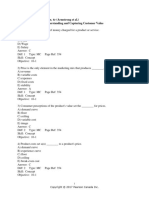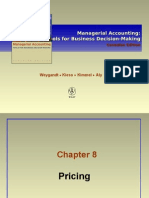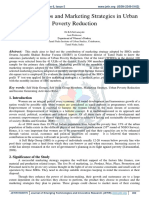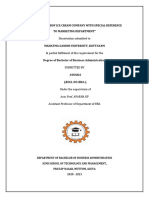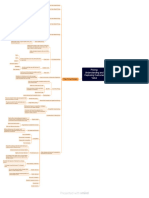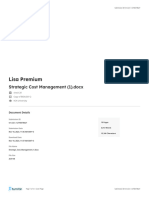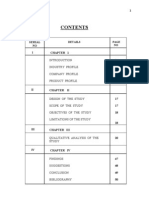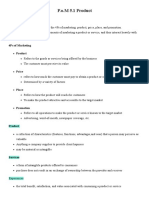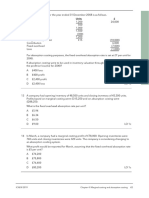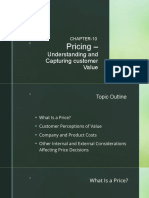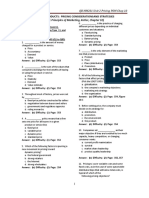As 7
As 7
Uploaded by
thea skywalkerCopyright:
Available Formats
As 7
As 7
Uploaded by
thea skywalkerOriginal Title
Copyright
Available Formats
Share this document
Did you find this document useful?
Is this content inappropriate?
Copyright:
Available Formats
As 7
As 7
Uploaded by
thea skywalkerCopyright:
Available Formats
*
CHAPTER 8
CHAPTER
REVENUE BASED
ACCOUNTING
STANDARDS
UNIT 1 : ACCOUNTING STANDARD 7
CONSTRUCTION CONTRACTS
LEARNING OUTCOMES
After studying this unit, you will be able to comprehend the provisions
of AS 7 related with:
♦ Introduction and Scope of Construction Contract
♦ Combining and Segmenting Construction Contracts
♦ What is included in Contract Revenue
♦ What is included and excluded in Contract Costs
♦ Recognition of Contract Revenue and Expenses
♦ Recognition of Expected Losses
♦ Changes in Estimates
♦ Disclosures.
© The Institute of Chartered Accountants of India
8.2 ADVANCED ACCOUNTING
1.1 SIGNIFICANCE OF THE STANDARD
The need to have a standard for construction contracts and their accounting
arises since the construction contracts generally cover more than one accounting
period. Common examples of construction include construction of flyovers, dams,
metro line, buildings etc. For example, if entity XY submits a tender to construct a
flyover for a state government, the construction of that flyover might take 2 to 3
years of time, depending on the scope of the contract. This standard addresses
the requirements for recognition & measurement (i.e., the timing and amount) of
construction revenue and construction costs.
Work in Progress
Start of construction End of construction
(Year 1) (Year 3)
The entity that is required to complete the construction is referred to as
Contractor and the customer who requires the construction to be completed is
referred to as Contractee/Customer.
Takes more than one
accounting year to
complete
Final outcome
determined after
Long term Peculiar no. of years from
projects Features of year of
Construction commencement of
construction
contracts
Allocation of contract
revenue and contract cost
tothe accounting period in
which construction work is
performed
© The Institute of Chartered Accountants of India
REVENUE BASED ACCOUNTING STANDARDS 8.3
The above discussion clearly indicates that there are two parties to the
construction contract. Thus, if there is an entity which requires its engineering
division to construct a machine for the production division, this would not meet
the scope of AS 7. It will be addressed by AS 10 (Property, plant and equipment)
and will be accounted as a case of self-constructed asset.
1.2 INTRODUCTION
Accounting Standard 7 prescribes the principles of accounting for construction
contracts in the financial statements of contractors. The focus of the standard is
to determine when the contractor should recognise contract revenue and contract
costs in the statement of profit and loss.
A construction contract is a contract specifically negotiated for the construction
of an asset or a combination of assets that are closely interrelated or
interdependent in terms of their design, technology and function or their ultimate
purpose or use.
A construction contract may be negotiated for the construction of a single asset
such as a bridge, building, dam, pipeline, road, ship or tunnel. A construction
contract may also deal with the construction of a number of assets which are
closely interrelated or interdependent in terms of their design, technology and
function or their ultimate purpose or use; examples of such contracts include
those for the construction of refineries and other complex pieces of plant or
equipment.
For the purposes of this Standard, construction contracts also include:
(a) contracts for the rendering of services which are directly related to the
construction of the asset, for example, those for the services of project
managers and architects; and
(b) contracts for destruction or restoration of assets, and the restoration of the
environment following the demolition of assets.
© The Institute of Chartered Accountants of India
8.4 ADVANCED ACCOUNTING
What are construction
Contracts?
Contracts specifically
Contracts for
negotiated for the Contracts for
rendering of services
construction of an asset or destruction or
related to
combination of assets that restoration of assets.
construction of assets
are closely interrelated
Example 1
Entity XY contracts with AB to construct 2 residential buildings in the same
premises. The construction of both buildings will begin simultaneously. Building
material, construction work, and other related activities will go on in parallel to
provide cost savings to entity XY. This also helps AB achieve a timely completion of
the two buildings and negotiate a consolidated price for the two buildings.
The above example suggests that there is a single contract negotiated to construct
two buildings that are closely interrelated and interdependent in terms of their
ultimate purpose and use. Therefore, this represents a Construction Contract.
Example 2
H, a sole-proprietor, contracts with M/s DM Construction, to dismantle his office
premises and construct it from scratch.
In the given case, the construction contract includes both demolition as well as
construction of a new building.
1.3 COMBINING AND SEGMENTING
CONSTRUCTION CONTRACTS
A contractor may undertake a number of contracts.
The standard identifies certain cases where for the purposes of accounting, it is
necessary to apply the Standard to the separately identifiable components of a
single contract or to a group of contracts together in order to reflect the
substance of a contract or a group of contracts.
© The Institute of Chartered Accountants of India
REVENUE BASED ACCOUNTING STANDARDS 8.5
(a) When a contract covers a number of assets, the construction of each asset
should be treated as a separate construction contract when:
(i) separate proposals have been submitted for each asset;
(ii) each asset has been subject to separate negotiation and the
contractor and customer have been able to accept or reject that part of the
contract relating to each asset; and
(iii) the costs and revenues of each asset can be identified.
(b) A group of contracts, whether with a single customer or with several
customers, should be treated as a single construction contract when:
(i) the group of contracts is negotiated as a single package;
(ii) the contracts are so closely interrelated that they are, in effect, part of
a single project with an overall profit margin; and
(iii) the contracts are performed concurrently or in a continuous sequence.
(c) A contract may provide for the construction of an additional asset at the
option of the customer or may be amended to include the construction of
an additional asset. The construction of the additional asset should be
treated as a separate construction contract when:
(i) the asset differs significantly in design, technology or function from
the asset or assets covered by the original contract; or
(ii) the price of the asset is negotiated without regard to the original
contract price.
Illustration 1
XYZ construction Ltd, a construction company undertakes the construction of an
industrial complex. It has separate proposals raised for each unit to be
constructed in the industrial complex. Since each unit is subject to separate
negotiation, he is able to identify the costs and revenues attributable to each
unit. Should XYZ Ltd, treat construction of each unit as a separate construction
contract according to AS 7?
© The Institute of Chartered Accountants of India
8.6 ADVANCED ACCOUNTING
Solution
As per AS 7 ‘Construction Contracts’, when a contract covers a number of assets,
the construction of each asset should be treated as a separate construction
contract when:
(a) separate proposals have been submitted for each asset;
(b) each asset has been subject to separate negotiation and the contractor and
customer have been able to accept or reject that part of the contract
relating to each asset; and
(c) the costs and revenues of each asset can be identified.
Therefore, XYZ Ltd. is required to treat construction of each unit as a separate
construction contract.
1.4 TYPES OF CONSTRUCTION CONTRACTS
Types of construction contracts
Fixed price contract Cost plus contract
Contractor agrees to a fixed contract Contractor is reimbursed for allowable
price or fixed rate per unit of output, or otherwise defined costs, plus
which in some cases is subject to cost percentage of these costs or a fixed fee.
escalation.
In a fixed price contract, the price is agreed as fixed sum or a fixed rate per unit
of output. In some cases, the contract may require the customer to pay additional
sums to compensate the contractor against cost escalations.
Fixed price contracts are common in case of public tenders (construction of roads,
flyovers, office buildings). Such constructions usually have a budgeted costs and
the public entity does not intend to spend more than the tender amount. At the
same time, there can be various reasons where the cost of construction may
increase. For example, a sudden increase in wage rates, construction material
© The Institute of Chartered Accountants of India
REVENUE BASED ACCOUNTING STANDARDS 8.7
costs, may require the contractor to add cost-escalation clauses and recover
from the contractee. These cost escalations still meet the category of fixed price
contracts.
A cost-plus contract is a construction contract in which the contractor is
reimbursed for allowable or otherwise defined costs, plus percentage of these
costs or a fixed fee.
Cost-plus contracts are common in case there is uncertainty of measurement of
costs or time of completion. In such cases, a contractor does not expect to bear
the loss due to those uncertainties. For example, if the scope of the contract
cannot be fully assessed in the contract, both parties may agree to cost-plus
contracts.
Under such contracts, the contractor is compensated for the costs incurred by
him plus agreed profit-margin.
1.5 CONTRACT REVENUE AND COSTS
(A) Contract revenue should comprise:
(i) the initial amount of revenue agreed in the contract; and
(ii) variations in contract work, claims and incentive payments to the
extent that it is probable that they will result in revenue and they are
capable of being reliably measured.
Contract revenue includes:
Agreed price (fixed / Cost-plus price)
Plus: Agreed Cost escalation
Plus: ∗Claims (reimbursement for costs not included in the contract price)
Plus: ∗∗
Incentive payments (usually for early completion)
Less: Penalties (usually for late completion)
Adjusted for Variations
∗
Claims are only included in contract revenue when it is probable that the customer will accept the
claim and such claim amount can be measured reliably
∗∗
Incentives are only included in the contract revenue when it is probable that the specified
performance standards will be met or exceeded, and such incentive payment can be measured
reliably)
© The Institute of Chartered Accountants of India
8.8 ADVANCED ACCOUNTING
Contract Revenue
Initially agreed amount
variations in contract work, claims and
incentive payments (if capable of being
recognized as revenue)
Illustration 2
AB contactors enters into a contract on 1st January 20X1 with XY to construct a 5-
storied building. Under the contract, AB is required to complete the construction in
3 years (i.e., by 31st December 20X3). The following information is relevant:
Fixed price (agreed) ₹5 crore
Material cost escalation (to the extent of 20% of increase in material cost)
Labour cost escalation (up to 30% of increase in minimum wages)
In case AB is able to complete the construction in less than 2 years and 10 months,
it will be entitled for an additional incentive of ₹50 lakh. However, in case the
construction is delayed beyond 3 years and 2 months, XY will charge a penalty of
₹20 lakh. At the start of the contract, AB has a reason to believe that construction
will be completed in 2 years and 8 months. Assume that the construction was
actually completed in 2 years 9 months.
Labour cost was originally estimated to be ₹1.20 crore (based on initial minimum
wages). However, the costs have increased by 25% during the construction period.
Material costs have increased by 40% due to short-supply. The total increase in
material cost due to the 40% escalation is ₹80 lakh.
You are required to suggest what should be the contract revenue in above case?
Assume that in year 20X2, XY has requested AB to increase the scope of the
contract. An additional floor is required to be constructed and there is an increase
in contract fee by ₹1 crore.
AB has incurred a cost of ₹20 lakh for getting the local authority approvals which it
will be entitled to claim from XY in addition to the increase in the fixed fee.
Also measure the total contract revenue in this case.
© The Institute of Chartered Accountants of India
REVENUE BASED ACCOUNTING STANDARDS 8.9
Solution
Total Revenue after considering the escalation costs, claims and incentives:
`
Fixed Price: 5.00 crore
Incentive for early completion 0.50 crore
Material costs recovery (to the extent of 20%) 0.40 crore
Labour costs recovery (Actual increase is less than 30%) 0.30 crore
[1.20 crore x 25%]
Total Contract Revenue 6.20 crore
Add: Variation to the contract 1.00 crore
Add: Claims recoverable from XY 0.20 crore
Total Contract Revenue 7.40 crore
(B) Contract costs should comprise:
(i) costs that relate directly to the specific contract;
(ii) costs that are attributable to contract activity in general and can be
allocated to the contract; and
(iii) such other costs as are specifically chargeable to the customer under
the terms of the contract.
Contract Costs
costs that are
costs that other costs as are
attributable to contract
relate directly specifically
activity in general and
to the specific chargeable to the
can be allocated to the
contract; customer under the
contract;
terms of the contract.
NOTE:
1. Examples of costs that relate directly to a specific contract include:
(a) site labour costs, including site supervision
(b) costs of materials used in construction
© The Institute of Chartered Accountants of India
8.10 ADVANCED ACCOUNTING
(c) depreciation of plant and equipment used on the contract
(d) costs of moving plant, equipment and materials to and from the
contract site
(e) costs of hiring plant and equipment
(f) costs of design and technical assistance that is directly related to the
contract
(g) the estimated costs of rectification and guarantee work, including
expected warranty costs
(h) claims from third parties
Note: Direct costs can be reduced by incidental income that is not included
in contract revenue, e.g., sale of surplus material and disposal of plant and
equipment.
2. Example of costs that may be attributable to contract activity in general and
can be allocated to specific contracts include:
(a) insurance
(b) costs of design and technical assistance that is not directly related to a
specific contract
(c) construction overheads
The allocation of indirect costs should be based on normal levels of
construction activity. The allocable costs may include borrowing costs
as per AS 16.
3. Examples of costs that cannot be attributed to contract activity or cannot be
allocated to a contract are excluded from the costs of a construction
contract. Such costs include:
(a) general administration costs for which reimbursement is not specified
in the contract
(b) selling costs
(c) research and development costs for which reimbursement is not
specified in the contract
(d) depreciation of idle plant and equipment that is not used on a
particular contract
© The Institute of Chartered Accountants of India
REVENUE BASED ACCOUNTING STANDARDS 8.11
Example 3: Cost-Plus contract
The language can be changed as under (Entire Question):
ABC Constructions has a contract to build an office building.
The terms and conditions are as under:
1. ABC’s profit is agreed at:
• 25% on expected contract’s cost; For this purpose, the expected cost
cannot exceed ₹ 22 crores.
2. The agreed price will be revised depending upon the actual cost incurred.
• The cost for fixation will be taken actual cost or ₹ 22 crores whichever
is less.
Price fixation based on expected cost:
Assume that the costs expected to be incurred by ABC are ₹16 crore. Thus, ABC
can charge a profit of ₹ 4 crores (25% on actual cost).
The contract price will be ₹ 20 crores. (₹16 crores plus ₹ 4 crores)
Price fixation based on actual cost incurred – Scenario 1:
However, if cost incurred by ABC is ₹15 crore, in that case, it would be able to
charge a profit of:
= 25% on ₹15 crore = 15 x 25% = ₹ 3.75 crore
Thus, Total Value of the contract will stand revised as follows:
= Actual Costs + Profit (25% of costs) = ₹ 15 crore + ₹ 3.75 crore = ₹ 18.75
crores.
Price fixation based on actual cost incurred – Scenario 2:
For any unavoidable reasons, if total cost incurred by ABC is ₹ 25 crore, it can only
charge a profit on the expected costs of ₹22 crore as under:
Thus, Total Value of the contract will stand revised as follows:
= Expected Costs + Profit (20% of costs) = ₹ 22 crore + ₹ 5.50 crore = ₹ 27.50
crores.
Analysis of the above scenario:
Cost actually incurred by ABC = ₹ 25 crores.
Actual profit earned by ABC = Total Value of the contract – Actual costs incurred
= ₹ 27.50 Crores – ₹ 25 Crores = ₹ 2.50 Crores.
© The Institute of Chartered Accountants of India
8.12 ADVANCED ACCOUNTING
1.6 PERCENTAGE COMPLETION METHOD
As discussed in the beginning, Construction contracts are mostly long term, i.e.,
they take more than one accounting year to complete. This means, the final
outcome (profit/ loss) of a construction contract can be determined only after a
number of years from the year of commencement of construction are over. It is
nevertheless possible to recognise revenue annually in proportion of progress of
work to be matched with corresponding construction costs incurred in that year.
This method of accounting, called the stage of completion method (percentage
completion method), provides useful information on the extent of contract
activity and performance during an accounting period.
The method is consistent with Accrual and Matching concepts of accounting.
AS 7 prescribes that the percentage completion method should not be used
unless it is possible to make a reasonable estimate of the final outcome of the
contract.
In reality, the actual profit or loss that is expected to be earned in such contracts
is not possible. Therefore, companies make use of different estimates to arrive at
the possible costs they are likely to incur for the construction. Large infra-
structure companies, builders expect to carry the required industry-experience.
On that basis, the pricing quoted by these companies for tenders take care of all
possible costs and expected profit. Therefore, in substance, a reasonable estimate
of the final outcome is possible in many such cases.
As per AS 7, the outcome of fixed price contracts can be estimated reliably when
all the following conditions are satisfied:
(i) total contract revenue can be measured reliably;
(ii) it is probable that the economic benefits associated with the contract will
flow to the enterprise;
(iii) both the contract costs to complete the contract and the stage of contract
completion at the reporting date can be measured reliably; and
(iv) the contract costs attributable to the contract can be clearly identified and
measured reliably so that actual contract costs incurred can be compared
with prior estimates.
© The Institute of Chartered Accountants of India
REVENUE BASED ACCOUNTING STANDARDS 8.13
The outcome of a cost-plus contract can be estimated reliably when all the
following conditions are satisfied:
(i) it is probable that the economic benefits associated with the contract will
flow to the enterprise; and
(ii) the contract costs attributable to the contract, whether or not specifically
reimbursable, can be clearly identified and measured reliably.
Flowchart depicting the conditions under which the outcome of a construction
contract can be reliably estimated:
Total contract revenue can be measured
reliably.
It is probable that the economic benefits
associated with the contract will flow to the
enterprise.
In fixed
price
contract
Both contract costs to complete the contract
and the stage of contract completion at the
reporting date can be measured reliably.
Outcome of Contract costs attributable to contract can be
clearly identified and measured reliably so that
contracts can be actual contract costs incurred can be
estimated reliably compared with prior estimates.
It is probable that the economic benefits
associated with the contract will flow to the
enterprise.
In cost
plus
contract
Contract costs attributable to the contract,
whether or not specifically reimbursable, can
be clearly identified and measured reliably.
© The Institute of Chartered Accountants of India
8.14 ADVANCED ACCOUNTING
Also, AS 7 provides that whenever total contract cost is expected to exceed the
total contract revenue, the loss should be recognised as an expense immediately.
We may argue that why would an entity enter into a loss-making contract. It can
happen that after having entered into the construction contract, there is a sudden
rise in the costs which was not expected, nor are these covered under the cost-
escalation clause. Another reason, is that, an entity may enter into a loss-making
contract is to penetrate the market. Therefore, it is not uncommon for companies
to sometimes enter into loss-making contracts.
Under the prudence concept, we must always make a provision for all
expected losses.
If the final oucome of the
contract
Can be estimated Cannot be estimated
reliably reliably
Revenue and costs Contract costs should be recognised as an expense
recognised as per Revenue should be recognised in the period in which they are incurred
percantage of completion only to the extent of contrct and
costs incurred, of which An expected loss on the construction contract
method considering the recovery is probable should be recognised asan expense immediately in
stage of completion of accordance with paragraph 35.
contract at reporting date.
Illustration 3 (Percentage completion method)
X Ltd. commenced a construction contract on 01-04-20X1. The fixed contract price
agreed was ₹2,00,000. The company incurred ₹81,000 in 20X1-X2 for 45% work
and received ₹79,000 as progress payment from the customer. The cost incurred in
20X2-X3 was ₹89,000 to complete the rest of work. Show the extract of the Profit
and Loss Account and Customer’s Account for the related years.
© The Institute of Chartered Accountants of India
REVENUE BASED ACCOUNTING STANDARDS 8.15
Solution
Profit & Loss Account
Year ` 000 Year ` 000
20X1-X2 To Construction 81 20X1-X2 By Contract Price 90
Costs (for 45% (45% of Contract
work) Price)
To Net profit 9
(for 45% work)
90 90
20X2-X3 To Construction 89 20X2-X3 By Contract Price 110
costs (55% of Contract
(for 55% work) Price)
To Net Profit 21
(for 55% work)
110 110
Customer’s Account
Year ` 000 Year ` 000
20X1-X2 To Contract 90 20X1-X2 By Bank 79
Price
By Balance 11
c/d
90 90
20X2-X3 To Balance b/d 11 20X2-X3
To Contract 110 By Bank 121
Price
121 121
AS 7 provides that the percentage completion method should not be applied if
the outcome of a construction contract cannot be estimated reliably. In such
cases:
© The Institute of Chartered Accountants of India
8.16 ADVANCED ACCOUNTING
(a) revenue should be recognised only to the extent of contract costs incurred
of which recovery is probable; and
(b) contract costs should be recognised as an expense in the period in which
they are incurred.
An expected loss on the construction contract should be recognised as an
expense immediately in accordance with paragraph 35.
Illustration 4
PQ & Associates undertakes a construction contract the details of which are
provided below:
Total Contract Value ₹40 lakh
Costs incurred to date ₹3 lakh
Estimated future costs of completion ₹30 lakh
Work completed 10%
The work has started some time ago and there is an uncertainty with respect to the
outcome of the contract due to expected changes in regulations. PQ is certain that
it would be able to recover the costs incurred to date.
Solution
In the given case, revenue and costs can only be recognised to the extent of the
costs incurred and those which are expected to be recovered. Therefore, the
profit & loss statement would appear as under:
Contract Revenue ₹3 lakh
Contract Costs ₹3 lakh
Contract Profit Nil
When the uncertainties that prevented the outcome of the contract being
estimated reliably cease to exist, revenue and expenses associated with the
construction contract should be recognised by the percentage completion
method.
© The Institute of Chartered Accountants of India
REVENUE BASED ACCOUNTING STANDARDS 8.17
Example 4
X Ltd. commenced a construction contract on 01/04/X1. The contract price agreed was
reimbursable cost plus 10%. The company incurred ₹1,00,000 in 20X1-X2, of which cost
of ₹90,000 is reimbursable. The further non-reimbursable costs to be incurred to
complete the contract are estimated at ₹5,000. The other costs to complete the contract
could not be estimated reliably. The Profit & Loss A/c extract of X Ltd. for 20X1-X2 is
shown below:
Solution
Profit & Loss Account
` 000 ` 000
By Contract Price
To Construction Costs 100 99
(90+9)
To Provision for loss 5 Net loss 6
105 105
1.7 TREATMENT OF COSTS RELATING TO
FUTURE ACTIVITY
Under the percentage of completion method, contract revenue is recognised as
revenue in the statement of profit and loss in the accounting periods in which the
work is performed. Contract costs are usually recognised as an expense in the
statement of profit and loss in the accounting periods in which the work to which
they relate is performed. The contract costs that relate to future activity on the
contract are however recognised as an asset provided it is probable that they will
be recovered. Such costs represent an amount due from the customer and are
often classified as contract work in progress.
1.8 UNCOLLECTABLE CONTRACT REVENUE
When an uncertainty arises about the collectability of an amount already included
in contract revenue, and already recognised in the statement of profit and loss,
the uncollectable amount or the amount in respect of which recovery has ceased
© The Institute of Chartered Accountants of India
8.18 ADVANCED ACCOUNTING
to be probable is recognised as an expense rather than as an adjustment of the
amount of contract revenue.
1.9 STAGE OF COMPLETION
The stage of completion of a contract may be determined in a variety of ways.
The enterprise uses the method that measures reliably the work performed.
Depending on the nature of the contract, the methods may include:
(a) the proportion that contract costs incurred for work performed up to the
reporting date bear to the estimated total contract costs; or
(b) surveys of work performed; or
(c) completion of a physical proportion of the contract work.
Progress payments and advances received from customers may not necessarily
reflect the work performed.
Calculation of Stage of completion under proportion of costs incurred
method.
This method may be useful in case of contracts where cost is closely monitored by
the contractor. This method could be more commonly used in case of private
contracts to construct office buildings, machinery or equipment.
Actual cost incurred
= ×100
Estimated total cost
Actual cost incurred
= ×100
Actual cost incurred + Estimated future costs
Calculation of Stage of completion under Surveyor of work performed
method
Generally, in case of government projects, a surveyor is appointed to oversee
various parameters like quality of work, material used, etc. Based on these
parameters, the surveyor would assess the percentage of work completed. The
certification done by the appointed surveyor is used as the percentage of work
completed.
© The Institute of Chartered Accountants of India
REVENUE BASED ACCOUNTING STANDARDS 8.19
Calculation of Stage of completion of a physical proportion of the contract
work method
This method is commonly used in case of construction work which is not very
complicated. For example, a contract to place tiles can be regarded as complete
on the basis of area covered as a proportion of total area expected to be covered.
Thus, for example If the area to be covered is 1,000 sq. ft., and the total area
already covered is 300 sq.ft., this implies that 30% of the work is completed.
Illustration 5 (Stage of completion for a loss-making contract)
Show Profit & Loss A/c (Extract) in books of a contractor in respect of the following
data for Year 1.
Information for Year 1 ` 000
Contract price (Fixed) 600
Cost incurred to date 390
Estimated cost to complete 260
Assume that the contract period is 2 years. The contract is 100% completed by
Year 2. Actual costs incurred is the same as total estimated costs to complete
(Cost incurred to date plus estimated cost to complete).
Solution
Amount INR ` 000
Year Total up to Year 2
(1) Year2 (2) (2) – (1)
A. Cost incurred to date (390) (650) (260)
B. Estimate of cost to completion (260) - -
C. Estimated total cost (650) 650 650
D. Degree of completion (A/C) 60% 100% 40%
E. Revenue Recognised
(60% of 600) 360
(100% of 600) 600 240
© The Institute of Chartered Accountants of India
8.20 ADVANCED ACCOUNTING
Total foreseeable loss (650 – 600) 50
Less: Loss for current year (E – A) (30)
Expected loss to be recognised immediately (20)
Reversal of Loss provision in Year 2 20
Profit & Loss A/c (Year 1)
` `
To Construction costs 390 By Contract Price 360
To Provision for loss 20 By Net Loss 50
410 410
Profit & Loss A/c (Year 2)
` `
To Construction costs 260 By Contract Price 240
By Reversal of Provision 20
for loss
260 260
1.10 CHANGES IN ESTIMATES
The percentage of completion method is applied on a cumulative basis in each
accounting period to the current estimates of contract revenue and contract
costs. Therefore, the effect of a change in the estimate of contract revenue or
contract costs, or the effect of a change in the estimate of the outcome of a
contract, is accounted for as a change in accounting estimate in accordance with
AS 5. The changed estimates are used in determination of the amount of revenue
and expenses recognised in the statement of profit and loss in the period in
which the change is made and in subsequent periods.
1.11 DISCLOSURE
(a) An enterprise should disclose:
(i) the amount of contract revenue recognised as revenue in the period;
© The Institute of Chartered Accountants of India
REVENUE BASED ACCOUNTING STANDARDS 8.21
(ii) the methods used to determine the contract revenue recognised in
the period; and
(iii) the methods used to determine the stage of completion of contracts
in progress.
(b) An enterprise should disclose following in respect of contracts in progress at
the reporting date:
(i) the aggregate amount of costs incurred and recognised profits (less
recognised losses) upto the reporting date;
(ii) the amount of advances received; and
(iii) the amount of retentions.
• Retentions are amounts of progress billings which are not paid
until the satisfaction of conditions specified in the contract for
the payment of such amounts or until defects have been
rectified.
• Progress billings are amounts billed for work performed on a
contract whether or not they have been paid by the customer.
• Advances are amounts received by the contractor before the
related work is performed.
(c) An enterprise should present:
(i) the gross amount due from customers for contract work as an asset; and
(ii) the gross amount due to customers for contract work as a liability.
Particulars `
Costs incurred xxx
Plus: Recognised profits xxx
Less: Recognised losses xxx
Less: Progress billings xxx
Amount xxx
If above amount is positive- Gross amount due from
customers
If above amount is negative- Gross amount due to
© The Institute of Chartered Accountants of India
8.22 ADVANCED ACCOUNTING
customers
Disclosures in Financial Statements
General Specific for contracts in progress
Amount of contract revenue recognised Aggregate amount of costs incurred
as revenue in the period and recognised profits (less recognised
losses) upto the reporting date
Methods used to determine the
contract revenue recognised in the
period Amount of advances received
Methods used to determine the stage
of completion of contracts in progress
Amount of retentions.
Illustration 6
A firm of contractors obtained a contract for construction of bridges across river
Revathi. The following details are available in the records kept for the year ended
31st March, 20X1.
( ` in lakhs)
Total Contract Price 1,000
Work Certified for the cost incurred 500
Work yet not Certified for the cost incurred 105
Estimated further Cost to Completion 495
Progress Payment Received 400
To be Received 140
The firm seeks your advice and assistance in the presentation of accounts keeping
in view the requirements of AS 7 issued by your institute.
© The Institute of Chartered Accountants of India
REVENUE BASED ACCOUNTING STANDARDS 8.23
Solution
(a) (` in lakhs)
Amount of foreseeable loss:
Total cost of construction (500 + 105 + 495) 1,100
Less: Total contract price (1,000)
Total foreseeable loss to be recognized as expense 100
According AS 7, when it is probable that total contract costs will exceed total
contract revenue, the expected loss should be recognized as an expense
immediately.
(b) (` in lakhs)
Contract work-in-progress i.e. cost incurred to date
are ₹ 605 lakhs
Work certified 500
Work not certified 105
605
This is 55% (605/1,100 × 100) of total costs of
construction.
(c) Proportion of total contract value recognized as revenue:
55% of ` 1,000 lakhs = ` 550 lakhs
(d) Gross Amount due from/to customers = (Contract costs + Recognized
profits – Recognized
Losses) – (Progress payments
received + Progress payments to be
received)
= (605 + Nil – 100) – (400 + 140)
` in lakhs
= [505 – 540] ` in lakhs
Amount due to customers = ` 35 lakhs
The amount of ` 35 lakhs will be shown in the balance sheet as liability.
© The Institute of Chartered Accountants of India
8.24 ADVANCED ACCOUNTING
(e) The relevant disclosures under AS 7 are given below:
` in lakhs
Contract revenue 550
Contract expenses 605
Recognised profits less recognised losses (100)
Progress billings ` (400 + 140) 540
Retentions (billed but not received from contractee) 140
Gross amount due to customers 35
Method of revenue recognition (use of percentage completion method)
Method of determining state of completion (based on proportionate cost
Illustration 7
On 1st December, 20X1, Vishwakarma Construction Co. Ltd. undertook a contract
to construct a building for ` 85 lakhs. On 31st March, 20X2, the company found
that it had already spent ` 64,99,000 on the construction. Prudent estimate of
additional cost for completion was ` 32,01,000. What amount should be recognized
in the statement of profit and loss for the year ended 31st March, 20X2 as per
provisions of Accounting Standard 7 (Revised)?
Solution
`
Cost incurred till 31 March, 20X2
st
64,99,000
Prudent estimate of additional cost for completion 32,01,000
Total cost of construction 97,00,000
Less: Contract price (85,00,000)
Total foreseeable loss 12,00,000
According to AS 7, the amount of ` 12,00,000 is required to be recognised as an
expense.
` 64, 99, 000 ×100
Contract work in progress = = 67%
97, 00, 000
© The Institute of Chartered Accountants of India
REVENUE BASED ACCOUNTING STANDARDS 8.25
Proportion of total contract value recognised as turnover:
= 67% of ` 85,00,000 = ` 56,95,000.
The amount of expected loss will be split as under:
Particulars Workings Amount
Expected Loss 97,00,000– 85,00,000 12,00,000
Contract revenue 67% of 85,00,000 56,95,000
Contract cost Given 64,99,000
Actual loss 56,95,000– 64,99,000 8,04,000
Amount of provision required 12,00,000– 8,04,000 3,96,000
[As per Para 35]
© The Institute of Chartered Accountants of India
8.26 ADVANCED ACCOUNTING
TEST YOUR KNOWLEDGE
Multiple Choice Questions (MCQ)
The below information relates to Questions 1 – 3:
XY Ltd. agrees to construct a building on behalf of its client GH Ltd. on 1st April
20X1. The expected completion time is 3 years. XY Ltd. incurred a cost of ` 30 lakh
up to 31st March 20X2. It is expected that additional costs of ` 90 lakh. Total
contract value is ` 112 lakh. As at 31st March 20X2, XY Ltd. has billed GH Ltd. for
` 42 lakh as per the agreement. Assume that the work is completed to the extent of
75% by the end of Year 2.
1. Revenue to be recognized by XY Ltd. for the year ended 31st March 20X2 is
(a) ` 28 lakh
(b) ` 42 lakh
(c) ` 30 lakh
(d) ` 32 lakh
2. Total expense to be recognised in Year 1 is
(a) ` 30 lakh
(b) ` 120 lakh
(c) ` 38 lakh
(d) ` 36 lakh
3. Revenue to be recognised for year 2 is
(a) ` 84 lakh
(b) ` 42 lakh
(c) ` 56 lakh
(d) ` 28 lakh
Below information relates to Questions 4 – 5
M/s AV has presented the information for Contract No. XY123:
Total contract value ` 370 lakh
© The Institute of Chartered Accountants of India
REVENUE BASED ACCOUNTING STANDARDS 8.27
Certified work completed ` 320 lakh
Costs incurred to date ` 360 lakh
Progress Payments received ` 300 lakh
Expected future costs to be incurred ` 50 lakh. The revenue to be recognised based on
the certified work completed.
4. Revenue to be recognised by M/s AV is
(a) ` 320 lakh
(b) ` 370 lakh
(c) ` 360 lakh
(d) ` 400 lakh
5. Total expense to be recognised by M/s AV is
(a) ` 380 lakh
(b) ` 400 lakh
(c) ` 320 lakh
(d) ` 360 lakh
6. LP Contractors undertakes a fixed price contract of ` 200 lakh. Transactions
related to the contract include:
Material purchased: ` 80 lakh
Unused material: ` 30 lakh
Labour charges: ` 60 lakh
Machine used for 3 years for the contract. Original cost of the machine is ` 100
lakh. Expected useful life is 15 years.
Estimated future costs to be incurred to complete the contract: ` 80 lakh.
Loss on contract to be recognised is:
(a) ` 40 lakh
(b) ` 10 lakh
(c) ` 90 lakh
(d) ` 50 lakh
© The Institute of Chartered Accountants of India
8.28 ADVANCED ACCOUNTING
Theory Questions
7. It is argued that profit on construction contracts should not be recognised
until the contract is completed. Please explain whether you believe that this
suggestion would improve the quality of financial reporting for long-term
construction contracts.
8. A contractor has entered into a contract with a municipal body for
construction of a flyover. As per the contract terms, the contractor will receive
an additional ` 2 Crore as incentive if the construction of the flyover were to
be finished within a period of two years from the start of the contract. The
contractor wants to recognize this revenue since in the past he has been able
to meet similar targets very easily.
Explain whether the contractor’s view-point is correct?
Practical Questions
9. A construction contractor has a fixed price contract for ` 9,000 lakhs to build a
bridge in 3 years time frame. A summary of some of the financial data is as
under:
(Amount ` in lakhs)
Year 1 Year 2 Year 3
Initial Amount for revenue agreed in 9,000 9,000 9,000
contract
Variation in Revenue (+) - 200 200
Contracts costs incurred up to the reporting 2,093 6,168* 8,100**
date
Estimated profit for whole contract 950 1,000 1,000
*Includes ` 100 lakhs for standard materials stored at the site to be used in
year 3 to complete the work.
**Excludes ` 100 lakhs for standard material brought forward from year 2.
The variation in cost and revenue in year 2 has been approved by customer.
© The Institute of Chartered Accountants of India
REVENUE BASED ACCOUNTING STANDARDS 8.29
Compute year wise amount of revenue, expenses, contract cost to complete
and profit or loss to be recognized in the Statement of Profit and Loss as
per AS-7 (revised).
10. Akar Ltd. Signed on 01/04/X1, a construction contract for ` 1,50,00,000.
Following particulars are extracted in respect of contract, for the year ended
31/03/X2.
- Materials used ` 71,00,000
- Labour charges paid ` 36,00,000
- Hire charges of plant ` 10,00,000
- Other contract cost incurred ` 15,00,000
- Labour charges of ` 2,00,000 are still outstanding on 31.3.X2.
- It is estimated that by spending further ` 33,50,000 the work can be
completed in all respect.
You are required to compute profit/loss for the year to be taken to
Profit & Loss Account and any provision for foreseeable loss to be
recognized as per AS 7.
11. RT Enterprises has entered into a fixed price contract for construction of a
tower with its customer. Initial tender price agreed is ` 220 crore. At the
start of the contract, it is estimated that total costs to be incurred will be
` 200 crore. At the end of year 1, this estimate stands revised to ` 202
crore. Assume that the construction is expected to be completed in 3 years.
During year 2, the customer has requested for a variation in the contract. As
a result of that, the total contract value will increase by ` 5 crore and the
costs will increase by ` 3 crore.
RT has decided to measure the stage of completion on the basis of the
proportion of contract costs incurred to the total estimated contract costs.
Contract costs incurred at the end of each year is:
Year 1: ` 52.52 crore
Year 2: ` 154.20 crore (including unused material of 2.5 crore)
© The Institute of Chartered Accountants of India
8.30 ADVANCED ACCOUNTING
Year 3: ` 205 crore.
You are required to calculate:
(a) Stage of completion for each year.
(b) Profit to be recognised for each year.
ANSWERS/SOLUTIONS
MCQ
1. (a) 2. (d) 3. (c) 4. (a) 5. (d) 6. (b)
Theory Questions
7. Usually, construction contracts are long term nature i.e., the contracts are
entered in one accounting period, however, the work performed will flow into
more than one accounting year. If the profit on construction contracts is not
recognised over the construction period, then the costs incurred during the
earlier years of the contract would be recognised without any corresponding
revenue. This will result in losses for initial years followed high profits in future
years.
The current treatment under AS 7 results in matching of revenue and
associated costs as they are recognised during the same period. Also, the
current accounting incorporates the prudence concept as any foreseeable
losses are accounted for immediately.
Therefore, AS 7 results in a fair representation of the underlying financial
substance of the transaction.
8. The contractor’s view is not entirely correct in considering the variation as a
part of contract revenue. There is an argument that he has been able to
complete similar contracts within stipulated time. However, each contract
needs to be assessed in isolation with respect to the specific challenges
associated with the timing and uncertainty in completion.
Accordingly, the contractor needs to validate the assumptions with respect to
the specific contract. Only after that assessment is done, the incentive of ` 2
crore may be included within the contract revenue.
© The Institute of Chartered Accountants of India
REVENUE BASED ACCOUNTING STANDARDS 8.31
Practical Questions
9. The amounts of revenue, expenses and profit recognized in the statement of
profit and loss in three years are computed below:
(Amount in ` lakhs)
Up to the Recognized Recognized in
reporting in previous current year
date years
Year 1
Revenue (9,000 x 26%) 2,340 - 2,340
Expenses (8,050 x 26%) 2,093 - 2,093
Profit 247 - 247
Year 2
Revenue (9,200 x 74%) 6,808 2,340 4,468
Expenses (8,200 x 74%) 6,068 2,093 3,975
Profit 740 247 493
Year 3
Revenue (9,200 x 100%) 9,200 6,808 2,392
Expenses (8,200 x 100%) 8,200 6,068 2,132
Profit 1,000 740 260
Working Note:
Year 1 Year 2 Year 3
Revenue after considering 9,000 9,200 9,200
variations 950 1,000 1,000
Less: Estimated profit for whole
contract
Estimated total cost of the 8,050 8,200 8,200
contract (A)
Actual cost incurred upto the 2,093 6,068 8,200
reporting date (B) (6,168-100) (8,100+100)
Degree of completion (B/A) 26% 74% 100%
© The Institute of Chartered Accountants of India
8.32 ADVANCED ACCOUNTING
10. Statement showing the amount of profit/loss to be taken to Profit and Loss
Account and additional provision for the foreseeable loss as per AS 7
Cost of Construction ` `
Material used 71,00,000
Labour Charges paid 36,00,000
Add: Outstanding on 31.03.20X2 38,00,000
2,00,000
Hire Charges of Plant 10,00,000
Other Contract cost incurred 15,00,000
Cost incurred upto 31.03.20X2 1,34,00,000
Add: Estimated future cost 33,50,000
Total Estimated cost of construction 1,67,50,000
Degree of completion (1,34,00,000/1,67,50,000 x 100) 80%
Revenue recognized (80% of 1,50,00,000) 1,20,00,000
Total foreseeable loss (1,67,50,000 - 1,50,00,000) 17,50,000
Less: Loss for the current year (1,34,00,000 - 1,20,00,000) 14,00,000
Loss to be provided for 3,50,000
11. (a) Stage of completion = Costs incurred to date / Total estimated costs
Year 1: 52.52 crore / 202 crore = 26%
Year 2: (154.20 crore – 2.50 crore) / 205 crore = 74%
Year 3: 205 crore / 205 crore = 100%
(b) Profit for the year
Year 1 Year 2 Year 3
Contract 57.20 crore 109.30 crore 58.50 crore
Revenue (1)
(220 crore x 26%) (225 crore x 74% - (225 crore x 100% -
57.20 crore) 109.30 crore –
57.20 crore)
© The Institute of Chartered Accountants of India
REVENUE BASED ACCOUNTING STANDARDS 8.33
Contract 52.52 crore 99.18 crore 53.30 crore
Cost (2)
(202 crore x 26%) (205 crore x 74% - (205 crore x 100% -
52.52 crore) 99.18 crore – 52.52
crore)
Contract 4.68 crore 10.12 crore 5.20 crore
Profit (1) –
(2)
© The Institute of Chartered Accountants of India
You might also like
- The Law of Construction Contracts in the Sultanate of Oman and the MENA RegionFrom EverandThe Law of Construction Contracts in the Sultanate of Oman and the MENA RegionNo ratings yet
- Contracts and SpecificationsDocument5 pagesContracts and SpecificationsmaryNo ratings yet
- 74708bos60485 Inter p1 cp8 U1Document33 pages74708bos60485 Inter p1 cp8 U1Gurusaran SNo ratings yet
- 74708bos60485-inter-p1-cp8-u1Document33 pages74708bos60485-inter-p1-cp8-u1harshrathore15590No ratings yet
- Contrat de ConstructionDocument36 pagesContrat de Constructionadelsahli140No ratings yet
- Slaid Kontraktor BHP CPCB 2023 - Ver2Document31 pagesSlaid Kontraktor BHP CPCB 2023 - Ver2sharveenanaiduNo ratings yet
- IAS 11 PresentationDocument33 pagesIAS 11 PresentationMoiez AliNo ratings yet
- As LB 17764Document27 pagesAs LB 17764ratiNo ratings yet
- Construction Contracts An AnalysisDocument29 pagesConstruction Contracts An Analysisemmanuel JohnyNo ratings yet
- 6 - Pdfsam - IAS & IFRS Bare StandardDocument1 page6 - Pdfsam - IAS & IFRS Bare StandarddskrishnaNo ratings yet
- 201.13 Accounting For Construction Contracts (IAS-11)Document17 pages201.13 Accounting For Construction Contracts (IAS-11)Biplob K. SannyasiNo ratings yet
- Submission Date: 15-06-2021: Course Code: AIS-407 Course Name: Financial Reporting & Professional IssuesDocument20 pagesSubmission Date: 15-06-2021: Course Code: AIS-407 Course Name: Financial Reporting & Professional IssuesShibajit HalderNo ratings yet
- As 7Document11 pagesAs 7ZerefNo ratings yet
- Accounting For Long Term Construction ContractsDocument34 pagesAccounting For Long Term Construction Contracts수지100% (1)
- Construction Contracts: International Accounting Standard 11Document4 pagesConstruction Contracts: International Accounting Standard 11Tin MolinaNo ratings yet
- Contract ProcurementDocument16 pagesContract ProcurementWAN NURULAIN ARIBAH BINTI WAN HASSANNo ratings yet
- Con MGTDocument9 pagesCon MGTIRSNo ratings yet
- C421 - Week 10Document36 pagesC421 - Week 10Luiwe SikhwariNo ratings yet
- Fa - Topic 3 Contract AccountDocument9 pagesFa - Topic 3 Contract AccountERICK ABDINo ratings yet
- 2.NOTES-Introduction To The Construction Process - (BWT110 - S1 - 2020 (2of4) )Document19 pages2.NOTES-Introduction To The Construction Process - (BWT110 - S1 - 2020 (2of4) )Pierre FourieNo ratings yet
- Ipsas 11 Construction Con 1Document26 pagesIpsas 11 Construction Con 1Tamer Adel Al ShipetyNo ratings yet
- Construction Management BookDocument100 pagesConstruction Management Bookffefcw100% (1)
- AS 7 - Construction ContractDocument13 pagesAS 7 - Construction Contractsourabhgoyal3075No ratings yet
- 6.1 Contracts ManagementDocument34 pages6.1 Contracts ManagementAmy MengistuNo ratings yet
- FR12 - Construction Contracts & Revenue (Stud)Document47 pagesFR12 - Construction Contracts & Revenue (Stud)duong duongNo ratings yet
- Lecture SevenDocument40 pagesLecture SevenMartaNo ratings yet
- Construction ContractsDocument5 pagesConstruction ContractsmasahinNo ratings yet
- Module No. 1 Contracts and SpecificationsDocument114 pagesModule No. 1 Contracts and SpecificationsCjoy De RoxasNo ratings yet
- Bkaf3093 Topic 7 Construction Sept2016Document50 pagesBkaf3093 Topic 7 Construction Sept2016pitot cuteNo ratings yet
- Construction Contract - WikipediaDocument33 pagesConstruction Contract - WikipediaYelisa Danny DenzelNo ratings yet
- Ch5 - Standard Forms of Building ContractDocument5 pagesCh5 - Standard Forms of Building ContracthaNo ratings yet
- Basics of Contract (By CAD DEC. 2020)Document25 pagesBasics of Contract (By CAD DEC. 2020)amcastanedaNo ratings yet
- Projects Analysis and Implementation Assignment-Ii: Group No: 4Document13 pagesProjects Analysis and Implementation Assignment-Ii: Group No: 4Bindu_Shree_4565No ratings yet
- 03 Construction Contracts Issues and Legal StructureDocument32 pages03 Construction Contracts Issues and Legal StructureN GraceNo ratings yet
- Forms of ContractsDocument15 pagesForms of ContractsNizar Kochery100% (1)
- EPC Contract Final Mr. SarangiDocument105 pagesEPC Contract Final Mr. SarangiSabyasachi Naik (Zico)100% (6)
- 1how To Use NEC3 NEC4Document3 pages1how To Use NEC3 NEC4aliNo ratings yet
- Formative Assessment # 8 - CONTRACT MANAGEMENTDocument3 pagesFormative Assessment # 8 - CONTRACT MANAGEMENTKenji Nicolai SalongaNo ratings yet
- Contract DocumentsDocument41 pagesContract Documentsrowlingsndiko15No ratings yet
- As - 7Document18 pagesAs - 7shagunpandat303No ratings yet
- IPSAS 11 CIMA - F2 - Text - Supplement - ConstructionDocument18 pagesIPSAS 11 CIMA - F2 - Text - Supplement - ConstructionReview Cpa TNo ratings yet
- Fidic Contract KLP 1Document6 pagesFidic Contract KLP 1Zulfadly BatubaraNo ratings yet
- Accounting StandardDocument8 pagesAccounting StandardOnkar Ashok KeljiNo ratings yet
- Afs 7Document4 pagesAfs 7Freddy Savio D'souzaNo ratings yet
- (LEC-2)Document22 pages(LEC-2)nk0000066666No ratings yet
- Contract, Specification and Quantity Survey Hand Out 2009E.CDocument12 pagesContract, Specification and Quantity Survey Hand Out 2009E.Cyeshi janexoNo ratings yet
- RR Construction Accounting QuestionsDocument18 pagesRR Construction Accounting QuestionsSharmaineMirandaNo ratings yet
- Contract Document Development StageDocument103 pagesContract Document Development StageMiz SamejonNo ratings yet
- Types of ContractDocument22 pagesTypes of ContractRico DumlaoNo ratings yet
- Conceiving and Drafting The Terms of Epc ContractsDocument8 pagesConceiving and Drafting The Terms of Epc Contractsaugustaq100% (2)
- 5 Key Types of Construction Contracts - Expert Guide For BuildersDocument22 pages5 Key Types of Construction Contracts - Expert Guide For BuildersViendong LeNo ratings yet
- Turn Key PDFDocument57 pagesTurn Key PDFFreddy VargasNo ratings yet
- IS Projects in KEnya PDFDocument6 pagesIS Projects in KEnya PDFGkou DojkuNo ratings yet
- IAS 11 - Construction Contracts (Study Material)Document9 pagesIAS 11 - Construction Contracts (Study Material)Nico Rivera CallangNo ratings yet
- Bert Bielefeld (Editor) - Basics Office Design-Birkhäuser (2018)Document68 pagesBert Bielefeld (Editor) - Basics Office Design-Birkhäuser (2018)Dobi DobNo ratings yet
- Reading 3 - Lecture 3 - 1-Construction - ContractsDocument31 pagesReading 3 - Lecture 3 - 1-Construction - ContractsElie OtayekNo ratings yet
- The Contractor Payment Application Audit: Guidance for Auditing AIA Documents G702 & G703From EverandThe Contractor Payment Application Audit: Guidance for Auditing AIA Documents G702 & G703No ratings yet
- Crafting a Comprehensive General Services Contract for Construction Projects: Construction Contracting DML, #1From EverandCrafting a Comprehensive General Services Contract for Construction Projects: Construction Contracting DML, #1No ratings yet
- Marketing of Banking Services Products Module D Paper 1 Support Services Download PDFDocument45 pagesMarketing of Banking Services Products Module D Paper 1 Support Services Download PDFarpita nayakNo ratings yet
- Lesson Note Pricing Short 2023 DDocument16 pagesLesson Note Pricing Short 2023 Dvibhanshujeet.r25No ratings yet
- Group 2 Business Plan With Chapter 5 6Document69 pagesGroup 2 Business Plan With Chapter 5 6Missha LoveNo ratings yet
- Chapter 8 Products, Services, and Branding StrategyDocument32 pagesChapter 8 Products, Services, and Branding StrategyNguyen Thi Thuy NganNo ratings yet
- Seal 6 Esolutions CH 15Document56 pagesSeal 6 Esolutions CH 15Katlego MasibiNo ratings yet
- Marketing An Introduction Canadian 6th Edition Armstrong Test BankDocument39 pagesMarketing An Introduction Canadian 6th Edition Armstrong Test Bankoleicgrin.k7rih100% (37)
- Weygandt Kieso Kimmel AlyDocument41 pagesWeygandt Kieso Kimmel AlyAssad AssadNo ratings yet
- JETIR1905H76Document12 pagesJETIR1905H76Nilanjana ChakrabartyNo ratings yet
- A Study On Meriiboy Ice Cream Company With Special Reference To Marketing DepartmentDocument49 pagesA Study On Meriiboy Ice Cream Company With Special Reference To Marketing DepartmentSruthy psNo ratings yet
- Pricing Decisions and Cost ManagementDocument22 pagesPricing Decisions and Cost ManagementDr. Alla Talal YassinNo ratings yet
- Pricing Understanding and Capturing Customer ValueDocument1 pagePricing Understanding and Capturing Customer ValueNguyễn NhiNo ratings yet
- Strategic Cost Management 1Document12 pagesStrategic Cost Management 1Study LiveNo ratings yet
- Chapter 13 Quiz: The Following Data Apply To Questions 6 and 7Document41 pagesChapter 13 Quiz: The Following Data Apply To Questions 6 and 7Dellya PutriNo ratings yet
- Key - Chapter 10Document52 pagesKey - Chapter 10otaku151104No ratings yet
- Practice Notes For Quantity Surveyors - Procurement StrategyDocument26 pagesPractice Notes For Quantity Surveyors - Procurement Strategyt ch100% (1)
- Contracts and SpecificationsDocument5 pagesContracts and SpecificationsDonna Cece MelgarNo ratings yet
- Oushadi ProjectDocument53 pagesOushadi ProjectRiyas Hassan T H100% (1)
- P.o.M 5.1 ProductDocument8 pagesP.o.M 5.1 ProductMaze ZeeNo ratings yet
- Learning Materials M4L1 Handouts Business PlanDocument34 pagesLearning Materials M4L1 Handouts Business PlanJonalyn RogandoNo ratings yet
- Chapter-5-Pricing-Calculations-CorrectedDocument14 pagesChapter-5-Pricing-Calculations-CorrectedngochuongotuonNo ratings yet
- Costing and Pricing Compressed 1 1Document60 pagesCosting and Pricing Compressed 1 1Banjo Calinagan Ventolero100% (1)
- Type of Family Tennis Membership Only Golf Membership OnlyDocument5 pagesType of Family Tennis Membership Only Golf Membership OnlySanchit KaushalNo ratings yet
- Pricing, Understanding and Capturing Customer ValueDocument22 pagesPricing, Understanding and Capturing Customer ValueGayle OzaetaNo ratings yet
- CONTRACT COSTING With IllustrationDocument10 pagesCONTRACT COSTING With IllustrationFikri SaiffullahNo ratings yet
- GROUP7 - Milk Divine Business PlanDocument13 pagesGROUP7 - Milk Divine Business PlanDianne SupilanasNo ratings yet
- Visual MerchandisingbookDocument108 pagesVisual MerchandisingbookNikita SinhaNo ratings yet
- Chap 10 Pricing - Understanding and Capturing Customer ValueDocument39 pagesChap 10 Pricing - Understanding and Capturing Customer Valuekazi sumaiya ehsanNo ratings yet
- Question & Answers: Commercial ContractingDocument13 pagesQuestion & Answers: Commercial Contractingpearl100% (2)
- MCQ On Unit 2 - Pricing With AnswersDocument14 pagesMCQ On Unit 2 - Pricing With AnswersAjay KareNo ratings yet
- ContractDocument11 pagesContractriyqNo ratings yet



